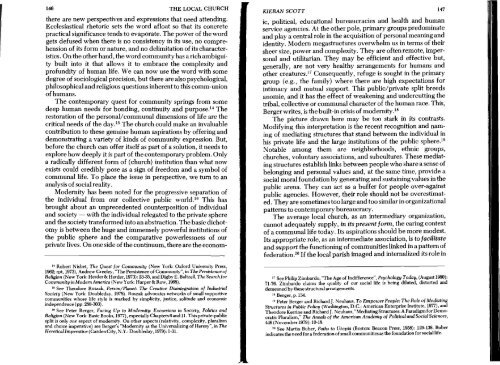The Local Church as an Ecology of Human Development - Fordham ...
The Local Church as an Ecology of Human Development - Fordham ...
The Local Church as an Ecology of Human Development - Fordham ...
- No tags were found...
Create successful ePaper yourself
Turn your PDF publications into a flip-book with our unique Google optimized e-Paper software.
146 THE LOCAL CHURCHthere are new perspectives <strong>an</strong>d expressions that need attending.Ecclesi<strong>as</strong>tical rhetoric sets the word afloat so that its concretepractical signific<strong>an</strong>ce tends to evaporate. <strong>The</strong> power <strong>of</strong> the wordgets defused when there is no consistency in its use, no comprehension<strong>of</strong> its form or nature, <strong>an</strong>d no delimitation <strong>of</strong> its characteristics.On the other h<strong>an</strong>d, the word community h<strong>as</strong> a rich ambiguitybuilt into it that allows it to embrace the complexity <strong>an</strong>dpr<strong>of</strong>undity <strong>of</strong> hum<strong>an</strong> life. We c<strong>an</strong> now use the word with somedegree <strong>of</strong> sociological precision, but there are also psychological,philosophical <strong>an</strong>d religious questions inherent to this comm-union<strong>of</strong> hum<strong>an</strong>s.<strong>The</strong> contemporary quest for community springs from somedeep hum<strong>an</strong> needs for bonding, continuity <strong>an</strong>d purpose.I 4 <strong>The</strong>restoration <strong>of</strong> the personal!communal dimensions <strong>of</strong> life are thecritical needs <strong>of</strong> the day.I5 <strong>The</strong> church could make <strong>an</strong> invaluablecontribution to these genuine hum<strong>an</strong> <strong>as</strong>pirations by <strong>of</strong>fering <strong>an</strong>ddemonstrating a variety <strong>of</strong> kinds <strong>of</strong> community expression. But,before the church c<strong>an</strong> <strong>of</strong>fer itself <strong>as</strong> part <strong>of</strong> a solution, it needs toexplore how deeply it is part <strong>of</strong> the contemporary problem. Onlya radically different form <strong>of</strong> (church) institution th<strong>an</strong> what nowexists could credibly pose <strong>as</strong> a sign <strong>of</strong> freedom <strong>an</strong>d a symbol <strong>of</strong>communal life. To place the issue in perspective, we turn to <strong>an</strong><strong>an</strong>alysis <strong>of</strong> social reality.Modernity h<strong>as</strong> been noted for the progressive separation <strong>of</strong>the individual from our collective public world.IS This h<strong>as</strong>brought about <strong>an</strong> unprecedented counterposition <strong>of</strong> individual<strong>an</strong>d society - with the individual relegated to the private sphere<strong>an</strong>d the society tr<strong>an</strong>sformed into <strong>an</strong> abstraction. <strong>The</strong> b<strong>as</strong>ic dichotomyis between the huge <strong>an</strong>d immensely powerful institutions <strong>of</strong>the public sphere <strong>an</strong>d the comparative powerlessness <strong>of</strong> ourprivate lives. On one side <strong>of</strong> the continuum, there are the econom14 Robert Nisbet, <strong>The</strong> Quest for Community (New York: Oxford University Press,1962; rpt, 1973), Andrew Greeley, "<strong>The</strong> Persistence <strong>of</strong> Community", in <strong>The</strong> Persistence <strong>of</strong>Religion (New York: Herder& Herder, 1973): 23-35, <strong>an</strong>d Digby E. Baltzell, <strong>The</strong> Search forCommunity in Modern America (New York: Harper&Row, 19(8).15 See <strong>The</strong>odore Roszak, Person/Pl<strong>an</strong>et: <strong>The</strong> Creative Disintegration <strong>of</strong> IndustrialSociety (New York: Doubleday, 1978). Roszak advocates networks <strong>of</strong> small supportivecommunities whose life style is marked by simplicity, justice, solitude <strong>an</strong>d economicindependence (pp. 288-303).16 See Peter Berger, Facing Up to Modernity: Excursions in Society, Politics <strong>an</strong>dReligion (New York: B<strong>as</strong>ic Books, 1977), especially Chapters 6 <strong>an</strong>d 11. This private-publicsplit is only one <strong>as</strong>pect <strong>of</strong> modernity. On other <strong>as</strong>pects (relativity, complexity, pluralism<strong>an</strong>d choice imperative) see Berger's "Modernity <strong>as</strong> the Universalizing <strong>of</strong> Heresy", in <strong>The</strong>Heretical Imperative (Garden City, N.Y.: Doubleday, 1979): 1-31.KIERAN SCOTTic, political, educational bureaucracies <strong>an</strong>d health <strong>an</strong>d hum<strong>an</strong>service agencies. At the other pole, primary groups predominate<strong>an</strong>d playa central role in the acquisition <strong>of</strong> personal me<strong>an</strong>ing <strong>an</strong>didentity. Modern meg<strong>as</strong>tructures overwhelm us in terms <strong>of</strong> theirsheer size, power <strong>an</strong>d complexity. <strong>The</strong>y are <strong>of</strong>ten remote, impersonal<strong>an</strong>d utilitari<strong>an</strong>. <strong>The</strong>y may be efficient <strong>an</strong>d effective but,generally, are not very healthy arr<strong>an</strong>gements for hum<strong>an</strong>s <strong>an</strong>dother creatures. 17 Consequently, refuge is sought in the primarygroup (e.g., the family) where there are high expectations forintimacy <strong>an</strong>d mutual support. This public/private split breeds<strong>an</strong>omie, <strong>an</strong>d it h<strong>as</strong> the effect <strong>of</strong> weakening <strong>an</strong>d undercutting thetribal, collective or communal character <strong>of</strong> the hum<strong>an</strong> race. This,Berger writes, is the built-in crisis <strong>of</strong> modernity,18<strong>The</strong> picture drawn here may be too stark in its contr<strong>as</strong>ts.Modifying this interpretation is the recent recognition <strong>an</strong>d naming<strong>of</strong> mediating structures that st<strong>an</strong>d between the individual inhis private life <strong>an</strong>d the large institutions <strong>of</strong> the public sphere. I9Notable among them are neighborhoods, ethnic groups,churches, voluntary <strong>as</strong>sociations, <strong>an</strong>d subcultures. <strong>The</strong>se mediatingstructures establish links between people who share a sense <strong>of</strong>belonging <strong>an</strong>d personal values <strong>an</strong>d, at the same time, provide <strong>as</strong>ocial moral foundation by generating <strong>an</strong>d sustaining values in thepublic arena. <strong>The</strong>y c<strong>an</strong> act <strong>as</strong> a buffer for people over-againstpublic agencies. However, their role should not be overestimated.<strong>The</strong>y are sometimes too large <strong>an</strong>d too similarin org<strong>an</strong>izationalpatterns to contemporary bureaucracy.<strong>The</strong> average local church, <strong>as</strong> <strong>an</strong> intermediary org<strong>an</strong>ization,c<strong>an</strong>not adequately supply, in its present form, the caring context<strong>of</strong> a communal life today. Its <strong>as</strong>pirations should be more modest.Its appropriate role, <strong>as</strong> <strong>an</strong> intermediate <strong>as</strong>sociation, is to facilitate<strong>an</strong>d support the functioning <strong>of</strong> communities linked in a pattern <strong>of</strong>federation. 20 If the local parish imaged <strong>an</strong>d internalized its role in17 See Philip Zimbardo, "<strong>The</strong> Age <strong>of</strong> Indifference", Psychology Today, (August 1980):71-76. Zimbardo claims the quality <strong>of</strong> our social life is being diluted, distorted <strong>an</strong>ddeme<strong>an</strong>ed by these structural arr<strong>an</strong>gements.18 Berger, p. 134.19 Peter Berger <strong>an</strong>d Richard J. Neuhaus, To Empower People: <strong>The</strong> Role <strong>of</strong> MediatingStructures in Public Policy (W<strong>as</strong>hington, D.C.: Americ<strong>an</strong> Enterprise Institute, 1977), <strong>an</strong>d<strong>The</strong>odore Kerrine <strong>an</strong>d Richard J. Neuhaus, "Mediating Structures: A Paradigm for DemocraticPluralism," <strong>The</strong> Annals <strong>of</strong> the Americ<strong>an</strong> Academy <strong>of</strong> Political <strong>an</strong>d Social Sciences,446 (November 1979): 10-18.20 See Martin Buber, Paths to Utopia (Boston: Beacon Press, 1958): 129-138. Buberindicates the need for a federation <strong>of</strong> small communities <strong>as</strong> the foundation for social life.147
















